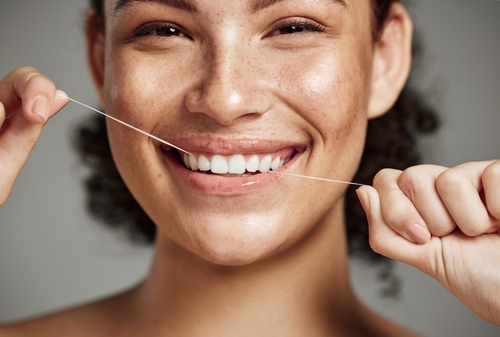Flossing: The Forgotten Key to Good Oral Health
 Flossing is an essential part of maintaining good oral hygiene. Unfortunately, it’s often neglected or forgotten by many people. While brushing is undoubtedly important, flossing is equally critical in preventing tooth decay, gum disease, and bad breath.
Flossing is an essential part of maintaining good oral hygiene. Unfortunately, it’s often neglected or forgotten by many people. While brushing is undoubtedly important, flossing is equally critical in preventing tooth decay, gum disease, and bad breath.
Learn more about the importance of flossing by contacting our Ashland, OR dentist, Dr. James Burneson at Today’s Dentistry.
Why Is Flossing Important?
Brushing your teeth can remove the plaque and food particles that stick to your teeth’ surfaces. However, it cannot effectively reach the spaces between your teeth, where bacteria can still thrive. Flossing helps remove these bacteria, preventing the buildup of plaque and tartar that can cause cavities, gum disease, and bad breath.
Gum disease, in particular, can be caused by the buildup of plaque on the gum line. This buildup can cause inflammation and bleeding, leading to gum recession and eventually tooth loss. Flossing helps to remove plaque from these areas, preventing the onset of gum disease.
How to Floss Correctly
Flossing correctly can be tricky, but it’s essential to do it properly to achieve maximum benefits. When flossing, make sure to follow these steps:
- Start with a piece of floss about 18 inches long. Wind most of the floss around one of your middle fingers, leaving about an inch or two of floss to work with.
- Hold the floss tightly between your thumb and forefinger, and gently slide it up and down between your teeth. Avoid snapping the floss into the gums, which can cause irritation or bleeding.
- Curve the floss around the base of each tooth, making sure to go beneath the gum line. Use a clean section of floss for each tooth to avoid spreading bacteria from one tooth to another.
- Be sure to floss both sides of each tooth, as well as the back of the last tooth in each row. Don’t forget to floss behind your back teeth too!
- Use a gentle back-and-forth motion to remove the floss from between your teeth.
- Rinse your mouth thoroughly with water, and then spit out the water and any remaining debris.
Flossing Tools
While traditional floss is a great option for many, there are various other flossing tools available that can make it easier and more effective. These tools may be especially helpful for those who struggle with traditional flossing methods.
Flossing tools include:
- Floss Picks: These are small, disposable tools that have a handle that makes it easy to floss between the teeth. They’re ideal for those who find it difficult to hold onto traditional floss or who have limited mobility in their hands.
- Water Flossers: These use a stream of water to remove plaque and food particles from between the teeth and along the gum line. They can be especially useful for people with braces, as they can clean harder-to-reach areas.
- Interdental Brushes: Small, cone-shaped brushes that are designed to clean between the teeth and around braces or other dental appliances. They come in various sizes to fit different spaces between teeth.
- Floss Threaders: Thin, flexible devices designed to help guide floss between teeth with braces or other dental appliances. Floss threaders can be helpful for those with tightly spaced teeth.
Why Choose Dr. Burneson?

Frequently Asked Questions
Ideally, you should floss at least once a day. However, if you have a history of gum disease or are prone to cavities, you may want to consider flossing more frequently.
There are different types of floss available, including waxed, unwaxed, flavored, and unflavored. The type of floss you use is largely a matter of personal preference. However, some types of floss, such as waxed floss, may be better at removing plaque from tight spaces.
Flossing should not be painful. If you experience pain or bleeding while flossing, it may be a sign of gum disease or another oral health issue. Be sure to talk to your dentist if you experience any pain or discomfort while flossing.
Invest in Your Oral Health
If you want to ensure that you’re taking care of your teeth and gums properly, don’t forget to floss regularly. Dr. Burneson at Today’s Dentistry is a skilled and experienced dentist who can provide you with personalized advice on maintaining good oral hygiene.
If you have any questions or concerns about flossing or your dental health in general, give us a call at (541) 482-7771 to schedule an appointment today. Your smile deserves the best care possible!
